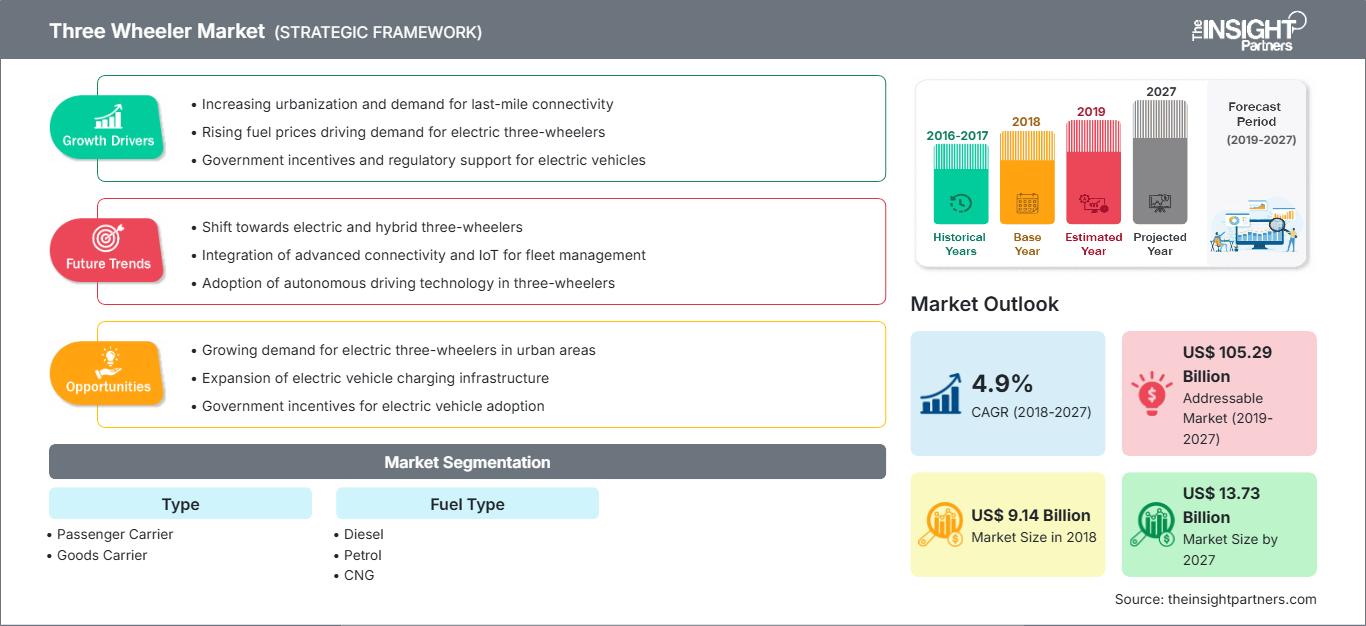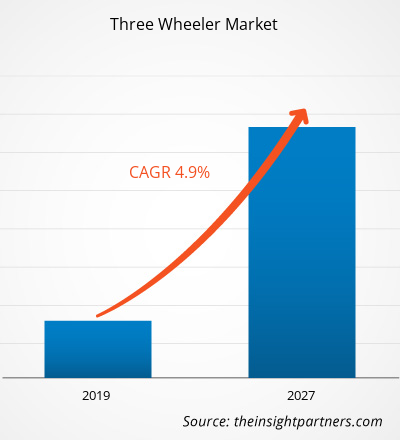Le marché des tricycles était évalué à 9,14 milliards de dollars américains en 2018 et devrait croître à un TCAC de 4,9 % de 2019 à 2027 pour atteindre 13,73 milliards de dollars américains d'ici 2027.
Les tricycles sont des véhicules à trois roues utilisés pour le transport de passagers. Un minimum de trois et un maximum de cinq à six passagers peuvent voyager sur ces véhicules. Dans les zones rurales, plus de six passagers voyagent sur ces véhicules, selon les besoins. Le pousse-pousse électrique est l'un des principaux types de tricycles. Les tricycles électriques fonctionnent sur batterie et sont des véhicules respectueux de l'environnement. Ils produisent des émissions de CO2 et sont moins bruyants que les tricycles classiques. Ils peuvent transporter cinq à six passagers. La demande croissante de tricycles électriques, la croissance démographique et le besoin croissant de véhicules permettant de fluidifier le trafic dans la région ont stimulé la croissance du marché mondial des tricycles. En 2018, la région Asie-Pacifique occupe une place prépondérante sur ce marché pendant la période de prévision. Des pays comme l'Inde devraient dominer le marché intérieur et les exportations pendant cette période. De plus, de nombreux acteurs indiens bien établis se concentrent sur la fabrication de tricycles conformes aux normes BS (Bharat Stage) VI, qui seront mises en œuvre d'ici 2020 pour limiter les émissions de particules fines, d'oxydes d'azote et de soufre. Une croissance significative est observée en Chine, suivie par d'autres pays asiatiques comme la Thaïlande et la Malaisie, en raison du besoin croissant de moyens de transport pour les zones rurales et semi-urbaines du pays et de la croissance démographique.
Vous bénéficierez d’une personnalisation sur n’importe quel rapport - gratuitement - y compris des parties de ce rapport, ou une analyse au niveau du pays, un pack de données Excel, ainsi que de profiter d’offres exceptionnelles et de réductions pour les start-ups et les universités
Marché des trois-roues: Perspectives stratégiques

-
Obtenez les principales tendances clés du marché de ce rapport.Cet échantillon GRATUIT comprendra une analyse de données, allant des tendances du marché aux estimations et prévisions.
L'industrie automobile mondiale connaît une augmentation constante du nombre de nouveaux fabricants de trois-roues. Les fabricants de trois-roues surveillent en permanence le développement du segment des trois-roues électriques, car ce segment suscite l'intérêt des clients du monde entier. L'industrie automobile mondiale connaît une transition importante des trois-roues traditionnels vers les trois-roues électriques.
Les gouvernements de divers pays prennent l'initiative d'adopter des trois-roues électriques. Par exemple, en mars 2018, le ministère indien des Industries lourdes et des Entreprises publiques a lancé la phase II du programme FAME India, qui a été lancé le 1er avril 2019 pour les trois prochaines années, avec un soutien budgétaire total de 1,39 milliard de dollars américains. Cette phase est lancée principalement pour soutenir l'électrification des véhicules publics et Le programme FAME vise à soutenir, par le biais de subventions, 7 000 bus électriques, 500 000 véhicules à trois roues électriques, 55 000 voitures particulières à quatre roues électriques et 10 000 véhicules à deux roues électriques. Cette phase du programme FAME vise à mettre en place une infrastructure de recharge publique adéquate afin de renforcer la confiance des utilisateurs de véhicules électriques. Le ministère des Industries lourdes et des Entreprises publiques souhaite ainsi impliquer et participer activement diverses parties prenantes, notamment les industries, les entreprises du secteur public et les agences gouvernementales. Les principaux acteurs du marché visent le développement des véhicules électriques. Par exemple, le constructeur automobile italien Piaggio & C. SpA a lancé le Piaggio Ape E-City dans sa gamme de véhicules électriques à trois roues Piaggio Ape Electrik. Ce véhicule électrique est équipé d'une batterie lithium-ion interchangeable et peut couvrir une autonomie d'environ 70 à 80 km après une seule charge. De plus, en août 2019, Euler Motors a annoncé le lancement de véhicules utilitaires légers à trois roues électriques en Inde début 2020.
Géographiquement, l'Inde et la Chine abritent de nombreux fabricants de trois roues, et l'acceptation de ces véhicules s'accroît rapidement d'année en année. Outre l'Inde et la Chine, des pays d'Amérique du Sud, comme le Brésil, l'Argentine, ainsi que des pays du Moyen-Orient et d'Afrique comme l'Afrique du Sud, le Nigéria et l'Égypte, connaissent également une croissance rapide en termes d'adoption des trois roues électriques dans l'industrie automobile. L'Asie-Pacifique a dominé et connaît une croissance considérable de l'industrie automobile. Néanmoins, les acteurs automobiles opérant dans la région doivent multiplier les partenariats avec les fournisseurs de composants afin de développer de manière exponentielle le déploiement de trois roues électriques. Les partenariats stratégiques, la collaboration, les contrats et les acquisitions avec d'autres acteurs du marché sont les principaux facteurs qui permettent aux acteurs du secteur de dynamiser leurs marchés, ce qui devrait stimuler le marché mondial des trois roues dans les années à venir.
Informations sur les types de véhicules
Dans le segment des types de véhicules, les véhicules de transport de passagers ont conquis la plus grande part du marché mondial des trois-roues. Les véhicules de transport de passagers sont les véhicules de transport les moins chers accessibles à divers opérateurs de transport privés et aux personnes dont les revenus proviennent du secteur. La croissance de ce segment est tirée par la demande croissante de véhicules de transport de passagers à bas prix, notamment en raison du manque de routes en bon état, de l'insuffisance des infrastructures de transport et de la forte congestion du trafic dans les zones urbaines.
Informations sur les types de carburant
Le marché des trois-roues, par type de carburant, est segmenté en diesel, essence, GNC, GPL et électrique. Le segment essence a conquis une part dominante du marché mondial des trois-roues.
L'initiative de marché est une stratégie adoptée par les entreprises pour étendre leur présence à l'échelle mondiale et répondre à la demande croissante des clients. Les acteurs du marché des trois-roues se concentrent principalement sur l'amélioration des produits et des services en intégrant des fonctionnalités et des technologies avancées. En signant des partenariats, des contrats, des coentreprises et en inaugurant de nouveaux bureaux à travers le monde, les entreprises cherchent à accroître leur part de marché et la présence de leur marque. La plupart de ces initiatives ont été observées dans la région Asie-Pacifique, qui présente un fort potentiel de croissance. En voici quelques-unes :
2019 : En décembre 2019, Greaves Cotton a annoncé un partenariat avec TVS Motor Company. Dans le cadre de ce partenariat, Greaves Cotton deviendrait centre de service agréé pour les tricycles de TVS Motor en Inde. 2018 : ATUL Auto Limited s'est associée à JBM Industries, une entreprise de pièces détachées automobiles basée en Inde. L'entreprise a conclu ce partenariat pour développer son activité de tricycles électriques.
Marché des trois roues
Les tendances régionales et les facteurs influençant le marché des tricycles tout au long de la période de prévision ont été analysés en détail par les analystes de The Insight Partners. Cette section aborde également les segments et la géographie du marché des tricycles en Amérique du Nord, en Europe, en Asie-Pacifique, au Moyen-Orient et en Afrique, ainsi qu'en Amérique du Sud et en Amérique centrale.
Portée du rapport sur le marché des véhicules à trois roues| Attribut de rapport | Détails |
|---|---|
| Taille du marché en 2018 | US$ 9.14 Billion |
| Taille du marché par 2027 | US$ 13.73 Billion |
| TCAC mondial (2018 - 2027) | 4.9% |
| Données historiques | 2016-2017 |
| Période de prévision | 2019-2027 |
| Segments couverts |
By Type
|
| Régions et pays couverts |
Amérique du Nord
|
| Leaders du marché et profils d'entreprises clés |
|
Densité des acteurs du marché des véhicules à trois roues : comprendre son impact sur la dynamique commerciale
Le marché des tricycles connaît une croissance rapide, portée par une demande croissante des utilisateurs finaux, due à des facteurs tels que l'évolution des préférences des consommateurs, les avancées technologiques et une meilleure connaissance des avantages du produit. Face à cette demande croissante, les entreprises élargissent leur offre, innovent pour répondre aux besoins des consommateurs et capitalisent sur les nouvelles tendances, ce qui alimente la croissance du marché.
- Obtenez le Marché des trois-roues Aperçu des principaux acteurs clés
- Transporteur de passagers
- Transporteur de marchandises
Marché des trois roues – Par type Par type de carburant
- Diesel
- Essence
- GNC
- GPL
- Électrique
Marché mondial des trois-roues par région
-
Amérique du Nord
- États-Unis
- Canada
- Mexique
-
Europe
- France
- Allemagne
- Italie
- Royaume-Uni
- Russie
- Reste de l'Europe
-
Asie-Pacifique
- Chine
- Inde
- Corée du Sud
- Japon
- Australie
- Reste de l'Asie-Pacifique
-
Reste du Monde
- Afrique
- Amérique latine
Profils d'entreprises
- ATUL Auto Limited
- Bajaj Auto Ltd.
- JS AUTO (P) LTD.
- Mahindra & Mahindra Ltd.
- Piaggio & C. SpA
- Scooters India Limited
- Speego Vehicles Co Pvt Limited
- Terra Motors Corporation
- TVS Motor Company
- Xianghe Qiangsheng Electric Tricycle Factory
- Analyse historique (2 ans), année de base, prévision (7 ans) avec TCAC
- Analyse PEST et SWOT
- Taille du marché Valeur / Volume - Mondial, Régional, Pays
- Industrie et paysage concurrentiel
- Ensemble de données Excel
Rapports récents
Rapports connexes
Témoignages
Raison d'acheter
- Prise de décision éclairée
- Compréhension de la dynamique du marché
- Analyse concurrentielle
- Connaissances clients
- Prévisions de marché
- Atténuation des risques
- Planification stratégique
- Justification des investissements
- Identification des marchés émergents
- Amélioration des stratégies marketing
- Amélioration de l'efficacité opérationnelle
- Alignement sur les tendances réglementaires






















 Obtenez un échantillon gratuit pour - Marché des trois-roues
Obtenez un échantillon gratuit pour - Marché des trois-roues